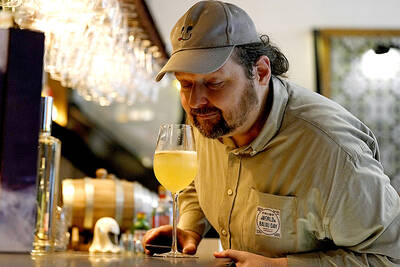Menswear, for the most part, has always seemed a sanctuary of sartorial sensibleness. Then, around five years ago, just as the designer Hedi Slimane was mastering his narrow silhouette for Dior Homme, came the return of the skinny jean. Suddenly, to be fashionable, men could no longer rely on a weathered pair of Levi’s 501s. Or a baseball cap. No, one’s silhouette had to be that of an emaciated house spider.
This season, menswear has been taken to new levels of skinniness. Guys, wince and whimper a painful “hello” to man-leggings, or “meggings.”
On the catwalk, in magazines, on the legs of industry “muses” such as Jethro Cave (son of Nick), meggings are everywhere. So I decided to take a pair for a spin one morning. Yes, I wore them into work. Not being Iggy Pop, Torvil or Dean, before I set out I picked up the phone and called another bandy-legged old pro, Justin Hawkins, the former leotard-clad lead squealer of camp-rockers the Darkness.
“Step and thrust; step and thrust,” came the sage words from Hawkins, who was on his way to Whitstable at the time with his new rock outfit, who are appropriately called Hot Legs. “Suck in your stomach,” he continued. “Go commando if you can brave it and watch out for those cold gusts.”
Strapped up like Rudolf Nureyev (I decided against Hawkins’ undergarment advice), I hobbled to work in a pair of sequined black leggings as conjured up by Belgian designer Martin Margiela. I looked like an evil mermaid and felt as if I was walking with a crotch full of staples.
But the response was fantastic. This must be how an X Factor winner feels the morning after the vote. Pretty girls smiled, tourists stopped me for a shoulder-hugging snap, builders wolf-whistled, colleagues cheered (mostly).
I looked very camp, but my inner fashion soul was thoroughly massaged.
Of course, it couldn’t last. I met my French, impossibly tasteful girlfriend after work for a celebratory drink. Juiced up with sartorial machismo, I approached her at our local bar. Looking up, then down, she covered her face with her pretty hands and pleaded, “Oh God, honey. You’re stinging my eyes.”

The unexpected collapse of the recall campaigns is being viewed through many lenses, most of them skewed and self-absorbed. The international media unsurprisingly focuses on what they perceive as the message that Taiwanese voters were sending in the failure of the mass recall, especially to China, the US and to friendly Western nations. This made some sense prior to early last month. One of the main arguments used by recall campaigners for recalling Chinese Nationalist Party (KMT) lawmakers was that they were too pro-China, and by extension not to be trusted with defending the nation. Also by extension, that argument could be

Aug. 4 to Aug. 10 When Coca-Cola finally pushed its way into Taiwan’s market in 1968, it allegedly vowed to wipe out its major domestic rival Hey Song within five years. But Hey Song, which began as a manual operation in a family cow shed in 1925, had proven its resilience, surviving numerous setbacks — including the loss of autonomy and nearly all its assets due to the Japanese colonial government’s wartime economic policy. By the 1960s, Hey Song had risen to the top of Taiwan’s beverage industry. This success was driven not only by president Chang Wen-chi’s

Last week, on the heels of the recall election that turned out so badly for Taiwan, came the news that US President Donald Trump had blocked the transit of President William Lai (賴清德) through the US on his way to Latin America. A few days later the international media reported that in June a scheduled visit by Minister of National Defense Wellington Koo (顧立雄) for high level meetings was canceled by the US after China’s President Xi Jinping (習近平) asked Trump to curb US engagement with Taiwan during a June phone call. The cancellation of Lai’s transit was a gaudy

The centuries-old fiery Chinese spirit baijiu (白酒), long associated with business dinners, is being reshaped to appeal to younger generations as its makers adapt to changing times. Mostly distilled from sorghum, the clear but pungent liquor contains as much as 60 percent alcohol. It’s the usual choice for toasts of gan bei (乾杯), the Chinese expression for bottoms up, and raucous drinking games. “If you like to drink spirits and you’ve never had baijiu, it’s kind of like eating noodles but you’ve never had spaghetti,” said Jim Boyce, a Canadian writer and wine expert who founded World Baijiu Day a decade